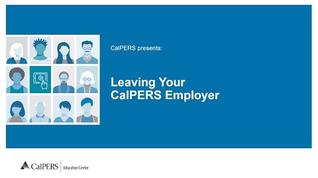Leaving CalPERS-Covered Employment
If you leave CalPERS-covered employment, you may:
- Retire
Leave your accumulated contributions in your account and receive a retirement benefit as soon as you meet the minimum retirement eligibility requirements. Access additional information regarding retirement and log in to your myCalPERS member account. - Elect a Refund of Contributions
Receive your accumulated contributions as a direct deposit or rollover. Electing a refund terminates your CalPERS membership. Ensure you're aware of any tax implications. Discover additional information regarding refunding. - Leave Contributions on Account & Elect to Retire When Eligible
Leave your accumulated contributions on account until you meet the minimum retirement eligibility requirements or meet the requirements for the federal required minimum distribution of age 72. Discover additional information regarding retirement requirements and for mandatory distributions.
If you're moving from one CalPERS-covered employer to another, review information regarding reciprocity.
If you're moving to a position covered under a reciprocal retirement system, you may not be able to withdraw your retirement contributions.
For more information about reciprocity, read When You Change Retirement Systems (PUB 16) (PDF). Watch our CalPERS Members: Early Career Basics video to learn more about leaving your employer. You can find additional resources by visiting Member Education.
If you separate from CalPERS employment, your health benefits, long-term-care benefits, and deferred compensation may be impacted.
Health Benefits Coverage
For information regarding health benefits coverage, visit the Health Benefits page.
Long-Term Care
If your premiums were paid as a payroll deduction, you'll need to contact CalPERS Long-Term Care to see what payment options are available. For information about long-term care, visit the Long-Term Care page.
Deferred Compensation Plans
When you leave CalPERS, you have several distribution options that may apply to your retirement savings goal. For information regarding deferred compensation plans, visit the Deferred Compensation page.
Videos



